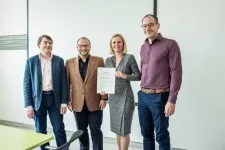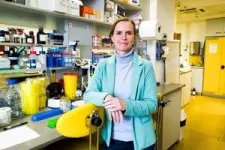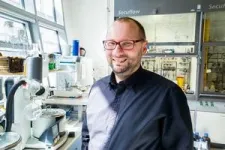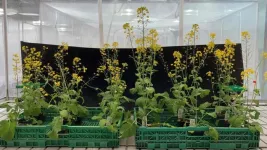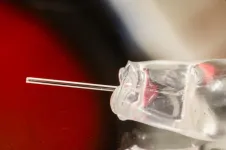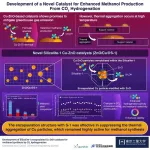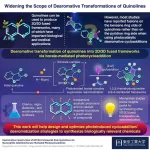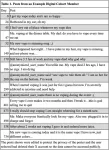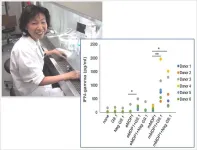(Press-News.org)
Technology from the laboratories of IOCB Prague has been given an extraordinary opportunity to succeed in the rapidly developing segment of gene therapy. The results of successful research are set to be advanced by a newly established private company called Adalid Sciences, which is being supported with a major investment from BTL Group, a leading manufacturer of medical technologies.
The story begins with the discovery of new lipid nanoparticles with a comic book name coined by Dr. Petr Cígler and Dr. Klára Grantz Šašková of IOCB Prague. Acting as a sort of imaginary courier, their XMAN is capable of safely transporting nucleic acids, either the basic building blocks of DNA or the long strands of RNA, into cells. At the same time, the potential of such a molecular transport device is constantly growing because the field of gene therapy has recently been developing at break-neck speed. Nucleic acids can be used to suppress or, conversely, replace or directly repair incorrect genetic information, making it possible to fight diseases that are difficult to treat. They also play an important role in the development of vaccines, both those targeting infectious diseases as well as oncological ones. Therefore, the new company, Adalid Sciences, has a unique opportunity to assume a permanent position in the global pharmaceutical market. This is also possible thanks to the extraordinary support provided by the IOCB environment, without which promising discoveries could hardly navigate the proverbial valley of death and have any hope of achieving commercial success. Professional support comes from the institute’s subsidiary transfer company, IOCB Tech, which helps bring promising scientific ideas to life.
“There’s something in the very DNA of our institute that inspires colleagues to not only engage in outstanding science but also to apply their results in practice. And we’ve been succeeding at this since the 1960s. Not only do Antonín Holý’s drugs have their predecessors, but they’ll hopefully also have their successors,” says IOCB director Prof. Jan Konvalinka. He continues: “I appreciate the fact that successful companies invest in modern technologies that can be beneficial to everyone. The contribution of IOCB Prague to this venture lies not only in our patent but also in our brilliant scientists. They’re truly among the best that Czech science has to offer.”
The investment that Adalid received from BTL is exceptional in the Czech milieu: a major manufacturer of medical technologies has promised to invest around ten million euros. The technical director of BTL, Tomáš Drbal, explains why they decided to take this step: “BTL Group is a world leader in several medical fields, so strategic investments in related areas such as biotech and pharma are a good match for the group’s vision. The outlook for the industry and the product is especially important to us, but even more important are the people who develop it. The credibility of the scientific institution from which they come to Adalid, as well as their professional and personal qualities, played a crucial role in our decision to make the investment.”
Adalid is being founded by IOCB researchers Klára Šašková, who will serve as the director of the new company, and Petr Cígler. In addition, one of the founders is the physician František Sedlák. Klára Šašková explains why, in her opinion, Adalid has a chance to break through: “Our advantage is that we offer lipid nanoparticles, which have significantly better properties compared to existing ones. Furthermore, not only do our particles demonstrate higher efficiency, they’re also nontoxic and are well tolerated by organisms even after repeated administration. Now we face challenging preclinical testing and negotiations with commercial partners looking for a transport system for their therapeutic nucleic acid. The goal is to get our products into clinical trials as soon as possible and emerge as one of the major players in the global field of genetic medicine.”
The groundbreaking research was published three years ago in the prestigious scientific journal Advanced Functional Materials, with the study overseen by Petr Cígler, head of the Synthetic Nanochemistry research group at IOCB Prague, who has extensive experience in developing functional transport systems for nucleic acids. He explains: “With the XMANs, we’ve managed to design a family of molecules with exceptional chemical and biological properties. We’ve been modifying the basic structure over time to improve those properties. We now have a number of unique substances that, together with nucleic acids, are capable of forming therapeutically highly active nanoparticles.”
Gene therapy offers therapeutic options for a wide range of incurable diseases, and it is already helping many people. Examples include patients with spinal muscular atrophy, congenital visual disorders, hemophilia, or oncological diseases. Thanks to scientific advances, hope is dawning for millions of others, and not just those with rare congenital diseases. The new Czech company Adalid Sciences is poised to play a key role in this important segment of contemporary medicine.
See the video: https://youtu.be/-tcp_vfLA3U
The Institute of Organic Chemistry and Biochemistry of the Czech Academy of Sciences / IOCB Prague (www.uochb.cz) is a leading internationally recognized scientific institution whose primary mission is the pursuit of basic research in chemical biology and medicinal chemistry, organic and materials chemistry, chemistry of natural substances, biochemistry and molecular biology, physical chemistry, theoretical chemistry, and analytical chemistry. An integral part of the IOCB Prague’s mission is the implementation of the results of basic research in practice. Emphasis on interdisciplinary research gives rise to a wide range of applications in medicine, pharmacy, and other fields.
END
A new study published in the academic journal Environmental Research Letters, reveals that the environmental impact of the February 3, 2023, Norfolk Southern train accident in East Palestine, Ohio covered a very large geographical area. Inorganic pollutants released due to the accident were found in wet weather downfall (wet deposition) from the Midwest through the Northeast reaching as far as southern Canada and North Carolina. The findings are significant as many inorganic pollutants in rain and snow have chemical effects on - aquatic flora and fauna. According to the paper, these pollutants spread over at least portions of 16 states and an area of 1.4 million ...
A team of researchers at the University of Zurich has discovered that plants benefit from a greater variety of interactions with pollinators and herbivores. Plants that are pollinated by insects and have to defend themselves against herbivores have evolved to be better adapted to different types of soil.
Plants obtain nutrients and water from the soil. Since different soil types differ in their chemical and physical composition, plants need to adapt their physiology to optimize this process on different soil types.
This evolutionary ...
When low doses of cancer drugs are administered continuously near malignant brain tumours using so-called iontronic technology, cancer cell growth drastically decreases. Researchers at Linköping University, Sweden, and the Medical University of Graz, Austria, demonstrated this in experiments with bird embryos. The results, published in the Journal of Controlled Release, is one step closer to new types of effective treatments for severe cancer forms.
Malignant brain tumours often recur despite surgery and post-treatment with chemotherapy and radiation. This is because cancer cells can “hide” deep within tissue and then regrow. ...
Conventional drug delivery is often like cracking a nut with a sledgehammer. Whether the drug is swallowed, injected, inhaled, or absorbed through the skin, it ultimately diffuses to most parts of the body, including those where it isn’t needed – or where it even might cause harm.
But what if the delivery could be targeted at exactly the right spot? This would allow the total dose to be dramatically lower, thus minimizing side-effects.
Now, scientists from the US have found a way to perfect a promising, ...
Osaka, Japan — As detrimental as viruses may sound, they can be helping hands for farmers when it comes to dealing with plant pathogens.
Osaka Metropolitan University scientists have discovered that a mycovirus that infects plant pathogenic oomycete Globisporangium ultimum can increase the latter’s sensitivity to specific fungicides. Their findings could lead to innovative approaches for controlling plant diseases, reducing reliance on chemical treatments, and minimizing agricultural loss.
Their results were published in Microbiological Research ...
Chemical sensors whose signals can be amplified by various triggers hold huge potential in multidisciplinary sciences. However, developing such systems was considered a highly challenging task, until a team of researchers from Tokyo Tech recently came up with a novel signal-amplification system that can be flexibly manipulated by a dynamic allosteric effector or a trigger. This new chemosensor system exhibited exception signal amplification by altering the sumanene monomer concentrations.
Synthetic supramolecular hosts and artificial receptors have found an exciting application in the form of chemical sensors or chemosensors, ...
An innovative synthesis strategy opened up the way to 2D/3D fused frameworks using inexpensive quinolines as feedstock, report scientists from Tokyo Tech. By leveraging a light-sensitive borate intermediate, the scientists could transform quinoline derivatives into a great variety of 2D/3D fused frameworks in a straightforward and cost-effective manner. Their findings are expected to enable the synthesis of highly customizable drug candidates.
Quinolines have garnered much attention from chemists wanting to synthesize compounds known as 2D/3D fused frameworks. These complex organic molecules have a lot of medical potential due to their highly ...
Measuring the heart rate of great apes in captivity is essential for both health management and animal studies. However, existing most methods are either invasive or inaccurate. Now, researchers from Japan have investigated the potential of using millimeter-wave radar technology to estimate heart rate from subtle body movements in chimpanzees. Their efforts will hopefully pave the way to better practices and techniques for monitoring heart rates in wild and captive primates.
Just like in humans, heart rate is a critically important and informative vital sign in nonhuman primates. Heart diseases are among the main causes ...
Tapping into the vast amount of data now available on social media, a new study from scientists at the University of California San Diego introduces a powerful new approach to understanding the nation’s health, in this case the vaping epidemic.
The study, published in the American Journal of Preventive Medicine on June 19, was led by John W. Ayers, Ph.D., from the Qualcomm Institute within UC San Diego.
“Researchers studying social media have tended to analyze the frequency and content of posts,” said Ayers, who is deputy director of informatics at the Altman Clinical and Translational Research Institute, vice chief of innovation in the Division of Infectious ...
Niigata, Japan - Tuberculosis is still one of the deadliest infectious diseases, causing over one million deaths each year worldwide. Additionally, about one-fourth of the world's population carries Mycobacterium tuberculosis (M. tuberculosis) without showing any symptoms, and most of these carriers do not develop the disease.
The current anti-tuberculosis vaccine, BCG, is administered worldwide. However, considering that more than 10 million new tuberculosis cases are reported each year, its effectiveness is deemed ...
